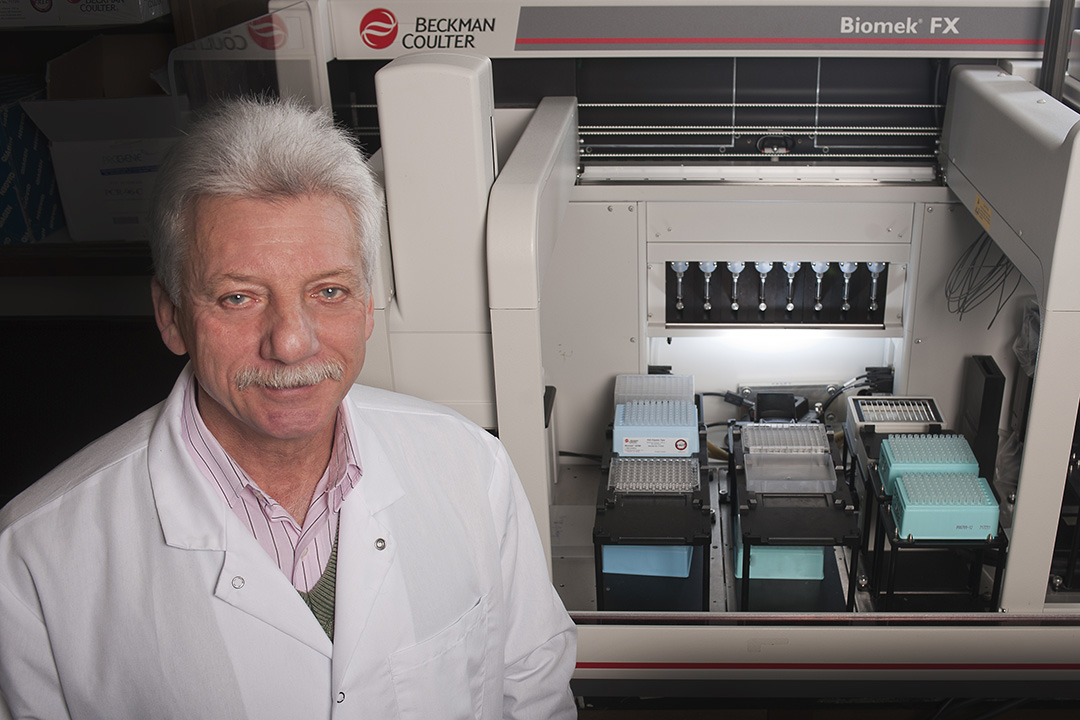
Cygler’s research targets pathogens at molecular level
On the front line in the battle against deadly antibiotic-resistant bacteria, Dr. Mirek Cygler (PhD) is exploring new tactics to combat the growing threat before it reaches pandemic proportions.
By James Shewaga“I’m not developing drugs and I’m not looking at how to cure disease: My research is dedicated to understand how pathogenic bacteria cause diseases, what are the tools they use. While we are not working directly on developing new drugs, my research might contribute to this goal in the long run,” said Cygler, a world-leading researcher in structural biology, based in the Department of Biochemistry, Microbiology and Immunology, College of Medicine, at the University of Saskatchewan (USask).
“I’m looking at how bacteria take over and rewire a human cell to convert it into a bacterium-safe environment. So, I am approaching bacterial-caused diseases through understanding exactly what happens during the infection process.”
Cygler’s research is largely focused on determining the role proteins play in bacteria’s ability to disable cell defences, to find new ways to interfere with the pathogen and get around the growing antibiotic resistance.
“Cells have many defence mechanisms and bacteria try to prevent those from working,” said Cygler. “So, we are getting structural insight into the interactions of bacterial proteins with their cellular targets to get clues on how they modify cell behaviour and we follow that with cell microbiology to understand what is happening inside the cell. That knowledge is a starting point toward trying to find a new way to prevent the disease.”
Cygler has more than 40 years of experience in his field, coming from Poland for post-doctoral training at the National Research Council of Canada (NRC) and University of Alberta. He then joined the NRC lab in Montreal, became an adjunct professor at McGill and moved to USask in 2011. A Fellow of the Canadian Academy of Health Sciences, Cygler was recently renewed as Canada Research Chair in Molecular Medicine Using Synchrotron Light. His lab employs Canada’s only synchrotron at USask’s Canadian Light Source facility to conduct cutting-edge research that could provide new weapons in the fight against antimicrobial resistance.
“My move here was definitely because I wanted to be closer to the synchrotron,” said Cygler, a member of the CLS Protein Crystallography Beamline Team. “The synchrotron is where we go to do our crucial experiments. All the protein production, purification and making protein crystals, it’s all done in the lab. The experiment that allows us to visualize protein structure in three dimensions is what we do there.”
Cygler’s lab examines protein structures—critical in the fight against bacteria, viruses and parasites—and the interaction between bacterial pathogens and host cells. He said the pharmaceutical industry is not spending much time and effort on developing new families of antibiotics, and the ones currently in use are becoming less effective due to overuse and misuse in medical treatment and food production, that lead to the spread antibiotic-resistant bacteria.
“Part of the problem is we thought (antibiotics) were miracle bullets that would be here forever, so we abused them, and of course that helped create resistance in bacteria over time,” said Cygler, adding that antibiotics attack both the bad and the good bacteria that a body needs. “Our antibiotics don’t just eradicate and kill all the pathogens, they eradicate all bacteria. And of course, we know now that our health depends on bacteria that are present in our bodies, for example in our digestive track. So, current antibiotics lack specificity to select only harmful bacteria.”
Rather than kill bacteria indiscriminately, Cygler hopes to identify precisely how bacteria modify cells, research that could lead to new compounds or new approaches to more pathogen-specific treatment down the road.
“A living cell is as complex as a huge city, so a lot of processes and their interconnections are still a black box and we need to understand what’s inside the black box,” he said.
Cygler’s own approach is to focus on basic science, while appreciating the importance of applied science. He believes universities need to focus on both parts of the research picture.
“What we need is to have a balance between basic and applied research,” said Cygler. “Applications are great and we all should support the science, but we must continue to fund basic research, because most of the applications that we have today didn’t come out of nowhere. They came from many, many years of very basic research where people were not asking the question of how do we cure this, they were asking the question of how does this organism work. To me, basic research is the long-term solution to problems like this.”
While the threat of antimicrobial resistance continues to grow, Cygler is hopeful that research will help us stay one step ahead of doomsday superbug scenarios.
“I hope and I believe that we will keep ahead of it,” he said. “But if no new treatments develop, it could be like the era before we had antibiotics and the flu could kill millions of people. I hope we will be able to meet the challenge, but we have to work on it. It could be a doomsday scenario, but I believe that we will not get to that point, that we will find new ways of interfering with infections.”
Article re-posted on .
View original article.
